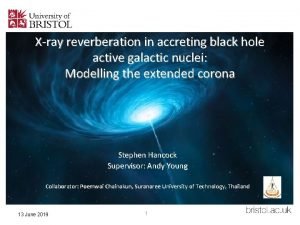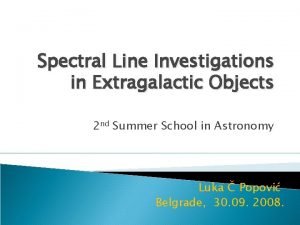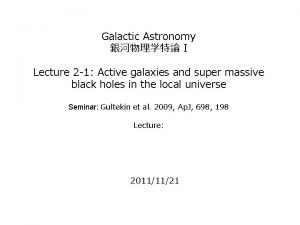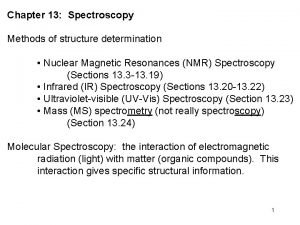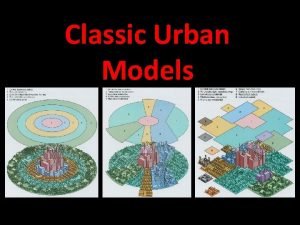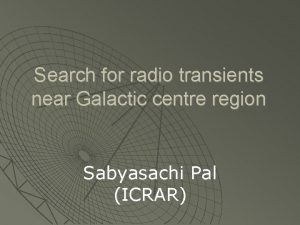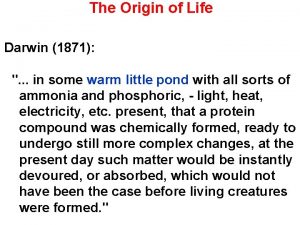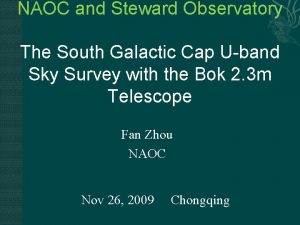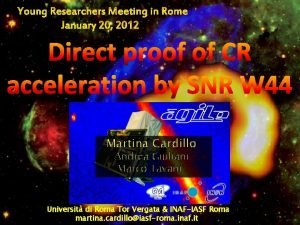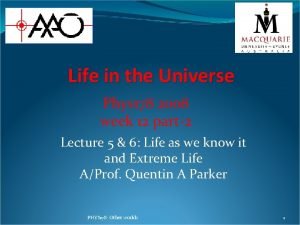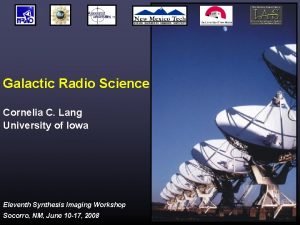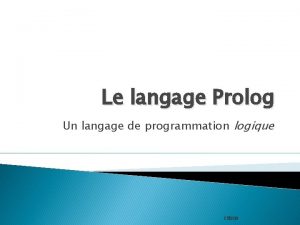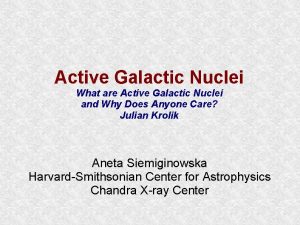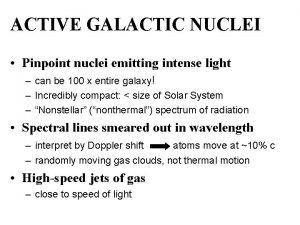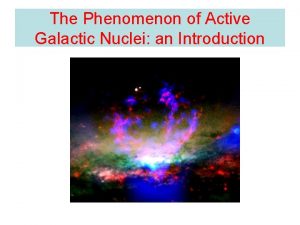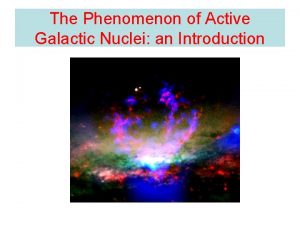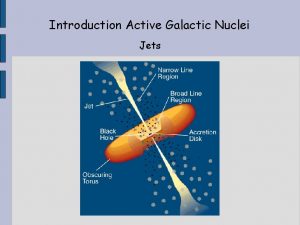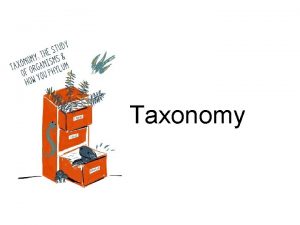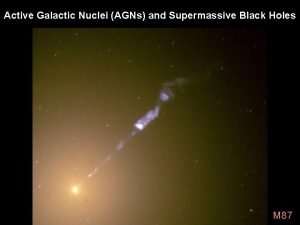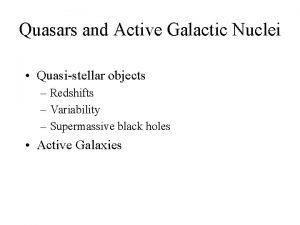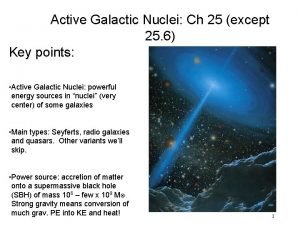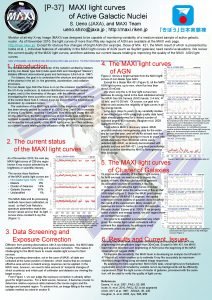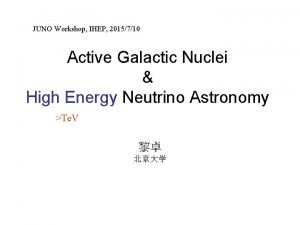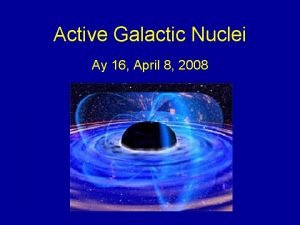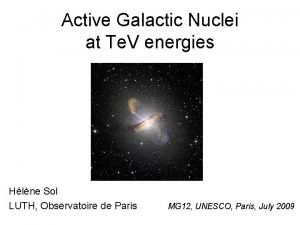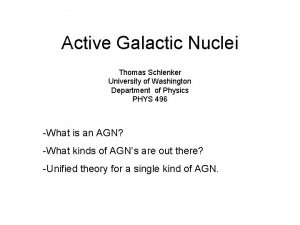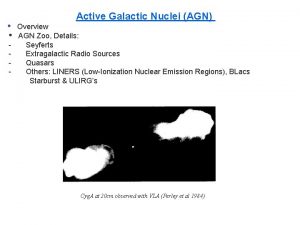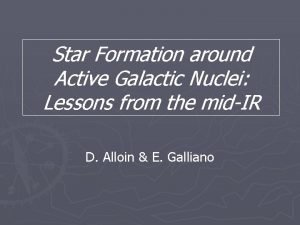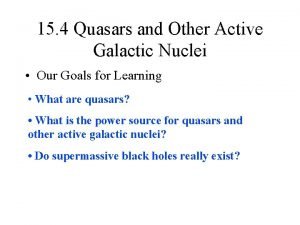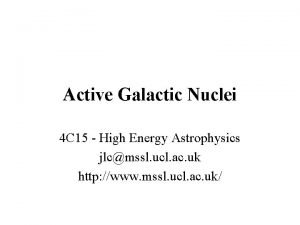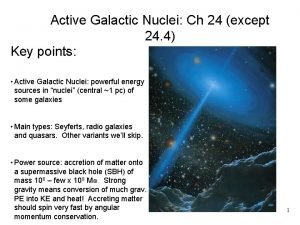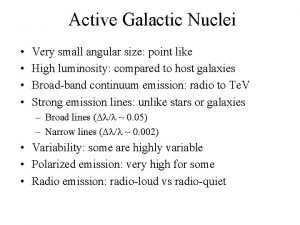Introduction Active Galactic Nuclei Lecture 2 Taxonomy Unification











![AGN taxonomy: LINERS LINER = Low-Ionization Narrow-Line Region They are characterized by [O II] AGN taxonomy: LINERS LINER = Low-Ionization Narrow-Line Region They are characterized by [O II]](https://slidetodoc.com/presentation_image_h/17b406295aa0b10fbef2c2559497b5b4/image-12.jpg)






















- Slides: 34

Introduction Active Galactic Nuclei Lecture -2 - Taxonomy & Unification

This Lecture Give a general overview of different types of AGN and some ideas on their unification Read Chapt. 2 & 7 of Peterson Read Chapt. 1. 3 of Krolik (optional)

Different types of AGN !

(The incomplete) AGN taxonomy Seyfert Galaxies Quasars & QSOs BAL QSO BL Lacs/OVV -> Blazar LINERS Radio Galaxies FRII (Read Chapt. 2 of Peterson for completeness!)

AGN diagnostic diagrams Sey gal H II gal LINERs The BPT diagrams are used in narrow-line emission systems, to distinguish between hard and soft radiation (Balwin, Phillips & Terlevich 1981, Veilleux & Ostrebrock 1987), which is usually ascribed to non-stellar and stellar activity, respectively.

AGN taxonomy: Seyfert galaxies Seyfert types: depends on width of the optical emission lines • Sy 2: narrow emission lines of FWHM ≤ few x 100 km s− 1 • Sy 1: broad permitted emission lines (Hα, He II, . . . ), of FWHM ≤ 104 km s− 1 that originate in a high-density medium (ne ≥ 109 cm− 3), and narrow-forbidden lines ([OIII], [N II], …) that originate in a low-density medium (ne ≈ 103− 106 cm− 3). • Sy 1. x (1. 9, 1. 8, . . . ): increase with the width Hα and Hβ lines. • NL Sy 1: subclass of Sy 2 with X-ray excess and optical Fe II in emission.

AGN taxonomy: Seyfert galaxies But the classification for a single object can change with time, due to AGN variability!

AGN taxonomy: Quasars & QSOs Quasar/QSR = Quasi Stellar Radio-source, QSO = Quasi-Stellar Object • Scaled-up version of a Seyfert, where the nucleus has a luminosity MB< − 21. 5 + 5 log h 0 (Schmidt & Green 1983). • Morphology is, most often, star-like. • Optical spectra similar to Sy 1 nuclei, with the exception that the narrow lines are generally weaker. Two varieties: • Radio-loud QSOs (Quasars or RL QSOs) • Radio-quiet QSOs (or RQ QSOs) Transitions at P 5 GHz≈1024. 7 W Hz− 1 sr– 1 / RL QSOs are 5− 10% of the total of

AGN taxonomy: Quasars & QSOs There is a big gap in radio power between RL and RQ varieties of QSOs (Kellerman et al. 1989, Miller et al. 1990) Only Steep-Spectrum PG Quasars! Radio quiet P 5 GHz≈1024. 7 W Hz− 1. Radio loud R=radio/optical flux (Miller et al. 1990) Falcke, Sherwood, Patnaik (1996)

AGN taxonomy: BAL QSOs = Broad Absorption Line QSOs Otherwise normal QSOs that show deep blue-shifted absorption lines corresponding to resonance lines of C IV, Si IV, N V. All of them are at z ≥ 1. 5 because the phenomenon is observed in the rest-frame UV. At these redshifts, they are about 10% of the observed population. BAL QSOs tend to be more polarized than non-BAL QSOs. (Ogle et al. 1999)

AGN taxonomy: Radio Galaxies Strong radio sources associated with giant elliptical galaxies, with optical spectra similar to Seyfert galaxies. Sub-classification according to: Optical spectra: NLRG = narrow-line radio galaxy, and BLRG = broad-line radio galaxy, with optical spectra similar to Sy 2 and Sy 1, respectively. Spectral index: At ν=1 GHz: steep or flat separated by α=− 0. 4 Radio morphology: Fanaroff & Riley (1974): measured by the ratio of the distance between the two brightest spots and the overall size of the radio image. FRI with R<0. 5 and FRII with R>0. 5
![AGN taxonomy LINERS LINER LowIonization NarrowLine Region They are characterized by O II AGN taxonomy: LINERS LINER = Low-Ionization Narrow-Line Region They are characterized by [O II]](https://slidetodoc.com/presentation_image_h/17b406295aa0b10fbef2c2559497b5b4/image-12.jpg)
AGN taxonomy: LINERS LINER = Low-Ionization Narrow-Line Region They are characterized by [O II] λ 3727Å / [O III] λ 5007Å ≥ 1 (Heckman 1980) [O I] λ 6300Å / [O III] λ 5007Å ≥ 1/3 Most of the nuclei of nearby galaxies are LINERs. A census of the brightest 250 galaxies in the nearby Universe shows that 50– 75% of giant galaxies have some weak LINER activity They are the weakest form of activity in the AGN zoo. One has to dig into the bulge spectrum sometimes to get the characteristic emission lines.

AGN taxonomy: LINERS LINER Spectrum

AGN taxonomy: BL Lac: Is the prototype of its class, an object, stellar in appearance, with very weak emission lines and variable, intense and highly polarized continuum. The weak lines often just appear in the most quiescent stages. Blazars: Encompass BL Lacs and optically violent-variable (OVV) QSOs. These are believed to be objects with a strong relativistically beamed jet in the line of sight.

AGN taxonomy: BL Lac (Vermeulen et al. 1994)

How can we bring all of these types of AGN into a (single) framework? We “postulate” a standard model for the structure of AGNs Different AGN-types result from different viewing angles (and maybe some different phycial conditions) Unification Evidence for unification?

The Unified Model of AGNs • Radio galaxies, quasars, QSOs, Seyferts, etc. are the same type of object viewed from different angles. • Centre of a galaxy is a black hole surrounded by an accretion disk, clouds of gas and a dusty torus. black hole • The energy output comes from accretion of material onto the black hole. St Mary’s

The standard model of AGN Components: Accretion disk: r ~ 10− 3 pc, n ~ 1015 cm− 3, v ~ 0. 3 c Broad Line Region (BLR): r ~ 0. 01 − 0. 1 pc, n ~ 1010 cm− 3, v ~ few x 103 km s− 1 Torus: r ~ 1 − 100 pc, n ~ 103 − 106 cm− 3 Narrow Line Region (NLR): r ~ 100− 1000 pc, n ~ 103 − 106 cm− 3, v ~ few x 100 km s− 1

Model for the central region of an active galaxy. A supermassive black hole in the center of the galaxy is surrounded by an accretion disk of infalling material. If conditions are right, the galaxy may also possess a magnetically-confined jet which could be the source of radio emission.

Effects of the orientation to AGN

Unification in AGN All AGN-type are the same but looked at from a different point of view This idea dates back to, at least, Rowan-Robinson (1977), and became popular in the mid-80 s (reviews by Lawrence 1987, Antonucci 1993, Urry & Padovani 1997, Goodrich 2001).

Support for unification: hidden emission lines Some Sy 2 s show broad lines in polarized light: The fraction is still unclear since the observed samples are biased towards high-P broad-band continuum objects. (Bill Keel´s web page with data from Miller, Goodrich & Mathews 1991, Capetti et al. 1995)

Support for unification: hidden emission lines Hot electrons scatter photons from the BLR near the nucleus to the observer. Dust torus shield direct line-of-sight to the nucleus s h p red Sc e att n oto Hence, Sy 2 look a bit like Sy 1 in polarised light

Support for unification: hidden emission lines

Support for unification: hidden emission lines NLRGs behave like Sy 2 s: Some NLRGs have hidden broad lines (Goodrich 2001). Polarized light aligns with the radio-axis, and the direction of polarization is perpendicular to it. (Cohen et al 1998)

Support for unification: ionization cones The ultraviolet emission comes from the accretion disk, lighting up a cone of glowing gas in the galaxy to the left. Only the cone of ultraviolet light can escape from the cavity in the accretion disk where the black hole lies; in other directions, the light is absorbed by the disk. (From STSc. I, modified by G. Rieke)

Support for unification: broad IR lines 25% of Sy 2 s show some broad component in the IR There are searches for broad-recombination lines in the near-IR spectrum of Sy 2 s, where the extinction affects the emitted spectrum less. They will be detectable if AV ≤ 11 mag for Paβ, AV ≤ 26 mag for Brγ and AV ≤ 68 mag for Brα. (Goodrich et al. 1994). λ (μm) (Veilleux, Goodrich & Hill 1997)

Support for unification: IR and NH excess The column of neutral H that absorbs the soft Xrays emitted by the nucleus is associated with the dust in the molecular torus, and thus provides a rough estimate of the dust content and the attenuation this provides. Sy 2 s have the largest absorption columns: The medium is Compton thick, so that X-rays are suppressed below 10 ke. V (Mushotzky 1982, Risaliti et al. 1999, Bassani et al. 1999). Sy 2 s also have colder IR colours than Sy 1 s: Explained if the torus is partially thick at mid-IR wavelengths. (Pérez-García et al. 1998): TSy 2=112 – 136 K TSy 1≈ 150 K (Risaliti et al. 1999)

Support for unification: other statistical tests • The continuum is stronger in Sy 1 s than in Sy 2 s (Lawrence 1987) • All Seyfert galaxies have a NLR with very similar properties (Cohen 1993) • Variability differs between different types (Lawrence 1987) • The size of the Sy 1 continuum emitting regions are smaller than those of Sy 2 s in HST images (Nelson et al. 1996)

Support for unification: direct imaging of torus?

(Bill Keel´s web page) Support for unification: direct imaging of torus? (Gallimore et al. 1997) VLBA observations of the nucleus of NGC 1068 (Sy 2) at 8. 4 GHz reveals a small elongated structure, probably an ionized disk of ~1. 2 pc at T≥ 106. 5 K that radiates free-free continuum or scattered light. (Gallimore, et al. 1997).

Additional Evidence for the Unified Model Quasar host galaxies: Number Counts: RLQs have the same types of hosts as FRII radio galaxies. A simple relationship is expected between the number of RLQs and FRII radio galaxies based on the obscuring angle of the torus. Environments (next lecture): RLQs and FRII radio galaxies occupy the similar (poor cluster/group) environments.

Where are the Type II Quasars? Only recently have we gained the technology to find these “hidden” quasars. Sensitive X-ray telescopes look for high energy photons penetrating the dust torus. Mid-IR observations: torus is transparent. X-ray: NASA/IOA/Fabian et al. , Optical: NASA/U. Durham/Smail et al.

General Summary AGN come in many forms and shapes. However some of their properties cross AGN-type “boundaries” This has led to a “Standard Model” of AGN In the centre of the AGN host is a black hole surrounded by an accretion disk, clouds of gas and a dusty torus, from which (sometimes) a jet eminates. AGN types are the results of mostly their orientation but also different physical circumstances (why a jet? )
 Active galactic nuclei
Active galactic nuclei Active galactic nuclei
Active galactic nuclei Active galactic nuclei
Active galactic nuclei Kendall and marzano's taxonomy
Kendall and marzano's taxonomy Nmr active and inactive nuclei
Nmr active and inactive nuclei 01:640:244 lecture notes - lecture 15: plat, idah, farad
01:640:244 lecture notes - lecture 15: plat, idah, farad Galactic address
Galactic address Multiple nuclei model example
Multiple nuclei model example Starwars combine
Starwars combine Galactic city model example
Galactic city model example Harris peripheral model
Harris peripheral model Galactic centre radio transients
Galactic centre radio transients Galactic habitable zone
Galactic habitable zone Galactic phonics ure
Galactic phonics ure Galactic cap review
Galactic cap review Alessandro cardillo
Alessandro cardillo Galactic habitable zone
Galactic habitable zone Galactic
Galactic Prolog langage
Prolog langage Unification of italy summary
Unification of italy summary Chapter 23 lesson 3 nationalism unification and reform
Chapter 23 lesson 3 nationalism unification and reform What was the most serious obstacle to german unification?
What was the most serious obstacle to german unification? Germany before unification
Germany before unification Strong devotion
Strong devotion Germany before unification
Germany before unification Unification operating model
Unification operating model Unification first order logic
Unification first order logic Why did germany avoid “wounding austria too severely”?
Why did germany avoid “wounding austria too severely”? Why was italian unification difficult to achieve
Why was italian unification difficult to achieve German and italian unification compare and contrast
German and italian unification compare and contrast Unification of china
Unification of china Prolog unification
Prolog unification Obstacles to german unification
Obstacles to german unification Unification algorithm example
Unification algorithm example Unification of germany class 10 mind map
Unification of germany class 10 mind map
